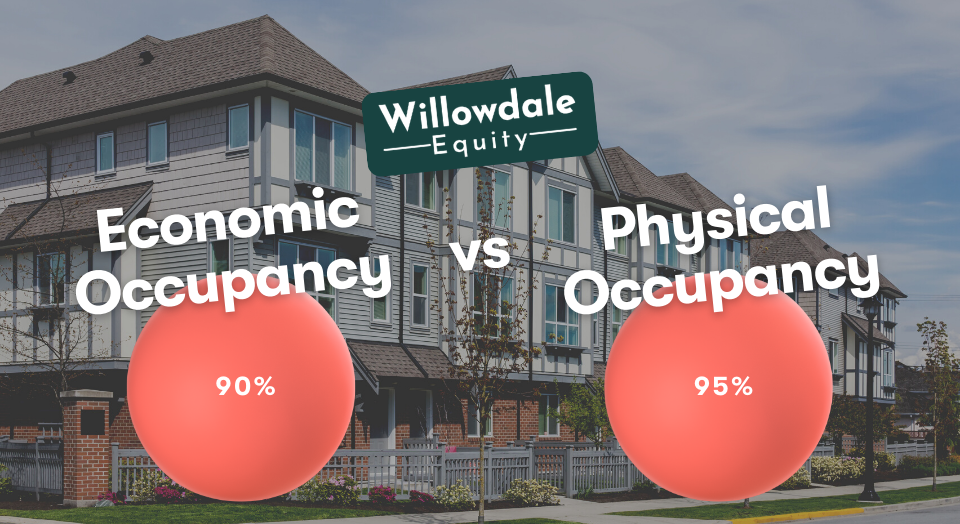
What is Economic Occupancy vs Physical Occupancy in Multifamily Real Estate
This article is part of our guide on passive investing in multifamily via syndication, available here.
Occupancy is one of the most fundamental pieces of a multifamily property. With no tenants occupying any units, the landlord is left on the hook for paying the mortgage, taxes, insurance, payroll, etc., out of pocket. But once you’re able to attract prospective tenants into your units, you next need to worry about if they will only physically occupy that unit or economically contribute to the apartment community by paying.
In this article, we’ll look what is economic occupancy vs physical occupancy and what that means for a multifamily property’s bottom line.
Key Takeaways
-
There’s more to the story than the faces that occupy the units, and getting the full story requires running this formula to understand the true performance of a multifamily property.
-
Physical occupancy accounts for simply the number of units physically occupied.
-
Economic occupancy in real estate is the number of units physically occupied by paying tenants or the percentage of income being collected relative to what’s scheduled to be collected.
What is Economic Occupancy in Real Estate?
Economic occupancy in real estate is the number of units physically occupied by paying tenants or the percentage of income being collected relative to what’s scheduled to be collected.
What is a Good Economic Occupancy?
A good economic occupancy rate is generally above 90%. So, if a 100-unit apartment complex collected rent from over 90% or 90 + units, that would be good.
Economic Occupancy Calculator
To calculate economic occupancy, you need the following formula:
Economic Occupancy= Gross Collected Rent / Gross Potential Rent
For Example: Let’s say there’s a 100-unit multifamily apartment community that’s 95% physically occupied with tenants paying $1,000/month, which brings in a total of $95,000 in gross scheduled rent.
The gross potential rent, if the property were 100% occupied, would be $100,0000.
If all 95 tenants are paying rent, then your economic occupancy would also be 95% but let’s say 5 were delinquent, and 3 had rent concessions and were only paying $900.
That means that we collected $1,000 from 87 tenants ($87,000), $0 from 5 tenants, and $900 from 3 tenants ($2,700) for a total of $89,700 ($2,700 + $ 87,000= $ 89,700)
To find our economic occupancy, we would perform the following formula ($89,700 / $100,000= 89.7% Economic Occupancy).
What is Physical Occupancy in Real Estate?
Physical occupancy in real estate is the number of units tenants physically occupy.
What is Economic Occupancy vs Physical Occupancy in Multifamily Real Estate
In a multifamily apartment community, there are several core differences to note between economic and physical occupancy, and they are as follows:
- Economic occupancy accounts for the number of paying units in an apartment community
- Physical occupancy accounts for simply the number of units physically occupied
- Economic occupancy paints a picture that the property is perhaps performing or over-performing
- Physical occupancy tells the real story of performance which affects your bottom line
If Economic Occupancy is 90%, What does that mean?
That means that you’re collecting 90% of what you should be collecting from the property. This is generally a ratio, but the goal should be to increase your physical occupancy rate as close as you can to 100% at market rent and collect as close as you can to 100% of the gross scheduled rent.
Related Read: What is the Breakeven Occupancy?
Why Economic Occupancy in Multifamily is so Important

Economic occupancy in multifamily is crucial because it’s a snapshot of the property’s overall income-earning performance. A true account of what’s actually being collected every month compared to what is asked of tenants every month.
The following are some of the reasons why a multifamily property would have a lower economic occupancy:
- High Vacancy: If you have a high physical vacancy, you can’t even collect, as your first job should be to physically fill those units with paying tenants. Vacancies can be caused by an array of issues such as market supply, bad reputation, poor management, lower desirable property, weak area, or due to some of the items listed below.
- Your Asking Rent is Too High: When your in-place rent is too high for your existing tenant base, this may lead to higher delinquency and lower economic occupancy. High asking rents also may lead to fewer move-ins, leading to higher vacancies and lower economic occupancy.
- Tenants Are Delinquent: Tenant delinquency is always an issue, especially when dealing with class b, c, and d tenant demographics. The lower the actual rental income earning potential of a cohort of people, the lower creditworthiness comes with it. Delinquency is a significant factor in lower economic occupancy. Even though you have tenants physically occupying units, you still have to chase a subset of them every month.
- Too Many Concessions: If you’re offering discounts, referred to as “concessions” in apartments, to attract new tenants, you’re collecting less than market rent. This might mean you’re collecting less than market to get them in, but it might be better long term to increase your economic occupancy; it’s a fine line for landlords.
Frequently Asked Questions About Economic Occupancy & Physical Occupancy
Economic vacancy in multifamily is the percentage of income that is not being collected relative to what’s scheduled to be collected.
Economic occupancy is affected by things like concessions, tenant delinquency, physical vacancies, and high asking rents, to name a few.
You take the number of occupied units and divide that number by the number of units you have.
What is Economic Occupancy vs Physical Occupancy - Conclusion
The bottom line is your true occupancy is not as simple as looking at how many tenants are sitting on the rent roll. There’s more to the story than the faces that occupy the units, and getting the full story requires running this formula to understand the true performance of a multifamily property.
If you’re interested in getting access to private value-add multifamily investment opportunities across the southeastern united states, join the investors club here at Willowdale Equity.
Interested In Learning More About PASSIVE Real Estate Investing In Multifamily Properties?
Get Access to the FREE 5 Day PASSIVE Real Estate Investing Crash Course.
In this video crash course, you’ll learn everything you need to know from A to Z
about passive investing in multifamily real estate.
We’ll cover topics like earned income vs passive income, the tax advantages, why multifamily, inflation, how syndications work, and much much more!




